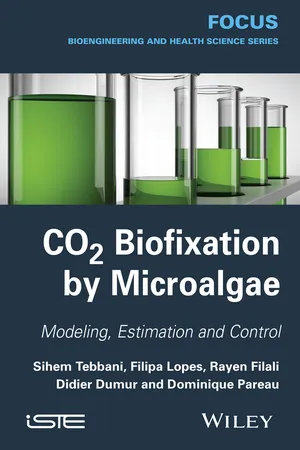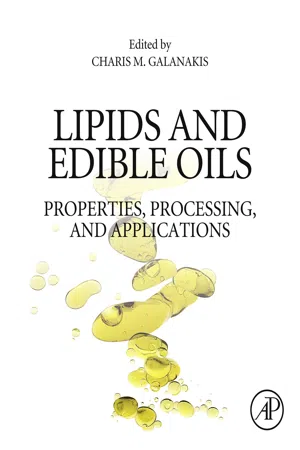Biological Sciences
Algae
Algae are a diverse group of photosynthetic organisms that can be found in various aquatic environments, including freshwater and marine habitats. They can range from single-celled microalgae to large, multicellular seaweeds. Algae play a crucial role in the ecosystem by producing oxygen and serving as a food source for various aquatic organisms.
Written by Perlego with AI-assistance
Related key terms
2 Key excerpts on "Algae"
- eBook - ePub
CO2 Biofixation by Microalgae
Modeling, Estimation and Control
- Sihem Tebbani, Rayen Filali, Filipa Lopes, Didier Dumur, Dominique Pareau(Authors)
- 2014(Publication Date)
- Wiley-ISTE(Publisher)
1
MicroAlgae
1.1. Definition
Algae are photosynthetic organisms that develop in varied habitats, predominantly in aquatic environments, capable of converting light energy and carbon sources, such as carbon dioxide (CO2 ), into “biomass”. Depending on their size, they can be classified into two broad categories: “macroAlgae” and “microAlgae”. MacroAlgae are multicellular Algae of around one centimeter in size which usually grow in ponds of natural fresh water or salt water. MicroAlgae have a size measured in micrometers and are considered to be single cell Algae which grow in suspension, mainly in aqueous solutions [WEN 09].These microorganisms are considered to be the first producers of oxygen (O2 ). Their existence in the oceans dates back to more than three billion years ago. They are responsible for transforming the composition of the atmosphere (CO2 fixation and O2 emission) and have allowed the emergence of plant and animal life on Earth. Also referred to as Phytoplankton , microAlgae represent a food source from the earliest stages of larval life right up to human beings, owing to their specific biochemical composition.Their adaptation and survival capacities are such that they are able to colonize all types of environments. They are found in thermal waters as well as in ice, in acidic or even hyper saline waters, in caves, in symbiotic relationships with any other type of living organisms, and as parasites, even on humans. They are also able to develop on hard surfaces, such as walls or tree trunks, and even on immersed structures. Certain species can withstand very low or paradoxically extreme temperatures. This faculty of adaptation is the result of their morphological properties as well as their capacity to synthesize different varieties of secondary metabolites.1.2. Characteristics
Through photosynthesis, these microorganisms synthesize O2 - eBook - ePub
Lipids and Edible Oils
Properties, Processing and Applications
- Charis M. Galanakis, Charis M. Galanakis(Authors)
- 2019(Publication Date)
- Academic Press(Publisher)
This transnational study is part of ERA-Net SUSFOOD2 project SUSPUFA, ID 145, funding provided by national respective countries sources and co-funding by the European Union's Horizon 2020 research and innovation program.5.1 Introduction
The term “microAlgae” is generically referred to a vast group of polyphyletic and highly diverse microorganisms ranging from prokaryotic cyanobacteria to eukaryotic single-celled organisms. These microorganisms perform photosynthesis but some can also use organic substrates to grow heterotrophically or mixotrophically.The cultivation of these microorganisms is quite recent (1960s), but their use as food collected from the environment by human population dates back centuries (Blackburn and Volkman, 2012 ). The cyanobacteria Nostoc sp. and Arthrospira sp. (formerly known as Spirulina) are the oldest reported, respectively, used by the Chinese population during famine 2000 years ago (Spolaore et al., 2006 ) and by the Mayan and Aztec civilizations in pre-Columbian times and by African communities in Chad (Ciferri and Tiboni, 1985 ). The number of microAlgae species living worldwide is currently estimated between 200,000 and 800,000 but only a few tens of thousands have been classified (Wolkers et al., 2011 ) and about 100 are well studied. In Europe, any food that had not been consumed to a significant degree by humans in the EU before May 15, 1997 is defined as Novel Food with a new regulation (Reg. 2015/2283) in force from the January 1, 2018. Few microAlgae and their derived products were on the EU food market before 1997, such as Arthrospira (Spirulina), Chlorella sp., Aphanizomenon sp., Dunaliella salina and are Food grade. Some microAlgae products were accredited for the EU novel food catalog such as PUFA rich oils form Schizochytrium sp. and Ulkenia sp., Astaxanthin-rich oleoresin from Haematococcus pluvialis , dried Odontella aurita , and Tetraselmis chuii . Others are under the evaluation process such as the eicosapentaenoic acid (20:5, n -3; EPA) rich oil from Phaeodactylum tricornutum and Nannochloropsis gaditana
Learn about this page
Index pages curate the most relevant extracts from our library of academic textbooks. They’ve been created using an in-house natural language model (NLM), each adding context and meaning to key research topics.

